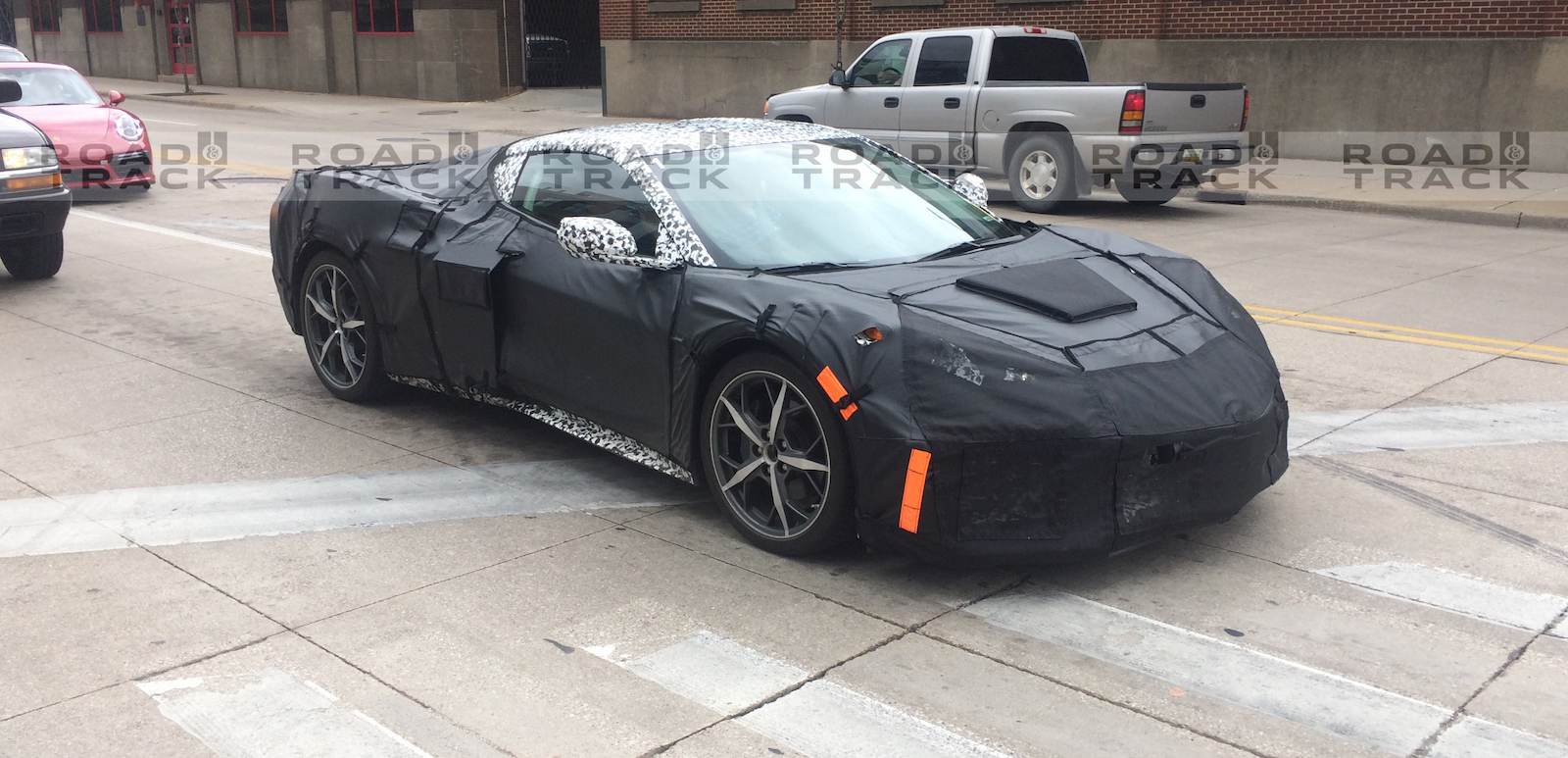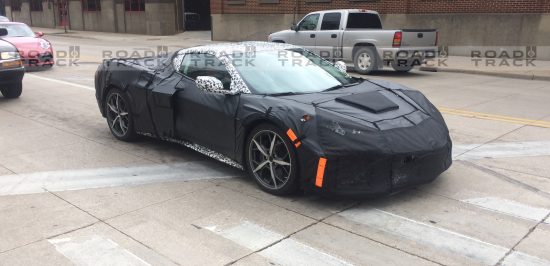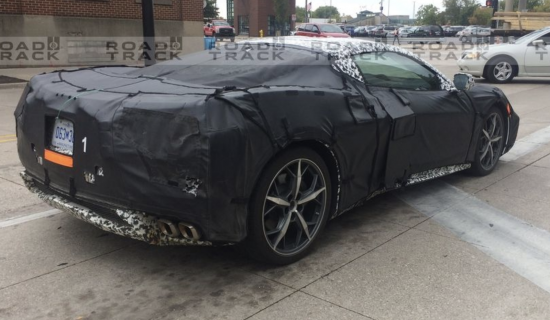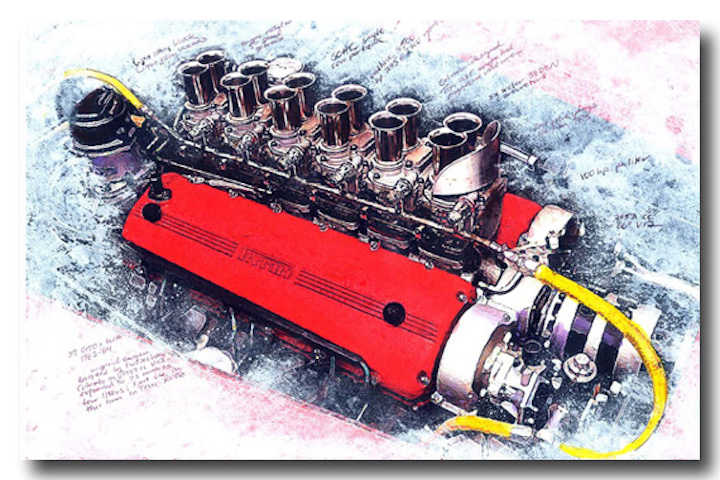by Wallace Wyss –
Collectively, we have all been waiting for a mid engined Corvette. I even drove one prototype, the Two Rotor, though it’s arguable that it was a Corvette because (as was accidentally revealed much later by Zora Arkus-Duntov while in his cups, was actually a Porsche 914 underneath).
But Motor Trend magazine, it seems like forever, has been touting the idea that a mid-engined Corvette is about to come out. Now Road & Track is echoing the prediction.
Only lately, albeit begrudgingly, do I began to give the idea some credibility because of spy pictures, one of which shows one up close, covered with camouflage, while there is also one in the background, just parked in the lot. Often when they are about to come out with a new car you see a little convoy of three to ten of the cars being driven merely to accumulate mileage; i.e. to see what breaks. I myself have been part of those convoys with other brands.
Allow me to launch some balloons with arguments, pro and con. You can shoot down the ones you wish (you might need a lot of ammo…).
AGAINST: WHY CHANGE WHAT WORKS?
Now the present day Corvette is front engine, and the higher in model you go the more profitable it is for GM. In fact the one close to $100,000 is probably twice as profitable as the lowest price one.
And they sell 30,000 to 40,000 Corvettes a year, even when the economy is having temporary dips.
The performance is robust even with the base model and I would argue that the cornering power of the front engine car is very close to that of a lot of mid-engined cars so the rationale of going mid-engined just to improve the cornering is laughable—does anyone care if the car gets a side lateral load of 1.1g if it already gets 0.95g?
One argument against going mid-engined is that the front engine Corvette has a good market niche. It was front engine when all the sports cars in America were front engine, save one (the Porsche 356) and only in recent decades has it been threatened by mid-engined cars (the Boxster being one that increasingly threatens it, as well as the Audi R8. If GM were to go mid-engined in the Corvette and only mid-engined, they would lose a market that has taken over 50 years to cultivate.
PRO: THE BEAUTY ARGUMENT
Mid-engined cars do not have to have a long, long hood because the engine is in the back (or amidships). So the mid-engined Corvette could take great strides in body style, freed at last of having to have a long hood. One worrisome thought is that Mercedes, in their two Image AMG Maybach prototypes, have bonnets as long as aircraft carrier decks, so they still are betting the long, long hood has appeal.
PRO: NEW CHASSIS PRESENTS OPPORTUNITY TO STEP INTO HYBRIDS
If a mid-engined Corvette is developed, there may be room in a new platform to give in a temptation by GM to include electric motors as well as an internal combustion engine. This would be an eye toward future regulation—there may be zones legislated into being in various cities where only non polluting cars can go.
If there is an all electric zone declared in certain “tourist” parts of the city, the hybrid mid engine Corvette could enter these zones and once sensors sense such a zone has been entered, switch to electric power. There are already cities picking a year, like Paris in the year 2030, saying no more internal combustion engines, so this would ensure the longevity of Corvettes. They wouldn’t all end up in the scrap heap of history.
PRO: THE TRICKLE DOWN THEORY
Whenever I mention “trickle down” at the radio station where I have a show, my liberal co-host starts ranting that the Reagan era theory was all rubbish but I say in cars you only have to point to the Porsche 959, a rare 4WD car, to see how many features “trickled down” from that rare car into regular Porsches. So if GM develops a mid-engined car, and re-designs a lot of items that comprise it, these items or the manufacturing processes devised to make them will benefit lower priced cars later.
PRO: GM WILL GET RUB OFF ON THE COMPANY AS A WHOLE
If GM can build a mid-engined car that can hold its own on road tests with Ferraris and Lamborghinis that cost three times as much they are crowing “We have the capability to beat you at your game and you’re specialists”. There would be good rub-off that will not only polish Chevy’s bowtie, but all of GM. Customers might think “If they can build a sports car this good, I’ll buy one of their other cars when I need an SUV, etc.”
AGAINST: I AM AGAINST ANY ENGINE WITH LESS THAN EIGHT CYLINDERS
The Corvette from ’55 to this date has been V8 powered, front engined and fiberglass. I say it’s enough to cope with changing audience perception to downsize the V8.
Does that mean a V6? I don’t like the idea, though I realize with twin turbos it could match many of today’s V8s. Ford’s new Ford GT has a V6 and I can’t help thinking “wimpy” when they could have had a same size V8. After all, the more cylinders you have the more you can keep running even if one or more cylinders fail, as witness the Cobra Daytona coupe that finished at LeMans with 7 cylinders. I would argue a V8 has the emotional appeal of continuing the tradition, just downsize it to 4 liters and have cylinder deactivation so in steady state cruising it could be a V6.
AGAINST: MID ENGINE CARS HAVE LIMITED ROOM
I go to quite a few of the Cars ‘n Coffee events and I have to say that the mid-engined cars always attract the most attention. Their owners, out for a morning drive, are not worried about luggage room.
I know there are those who think driving a mid-engined car home would automatically elicit the line from a wife of “But where do we put the suitcases?” but maybe they will have luggage attachments whereby special luggage locks on the roof or rear deck as in the days of prewar Grand Touring (or even special luggage that can be locked onto the rear deck as I saw on a ’27 Mercedes that won Pebble Beach). When only going out for breakfast you don’t need luggage space. And dare I say you can always change wives…?
AGAINST: OLDSTERS CAN’T SQUAT
I think by the time an affluent customer has his house pretty well paid for (and it’s now worth four times what he paid for it 30 years ago) he might think “This is my last chance to get an ultimate sports car.” But he won’t want to go Ferrari or Lamborghini, that’s just leaping too far into the darkness, mechanical updates wise. Corvettes he knows. But one argument against mid-engined cars is ingress and egress. You might have to be limber, and for that I say bring back the half gullwing, there was a 300SL roadster ordered once with a hardtop that had gullwing doors in the roof only (not cutting down into the doors). That would solve that problem when the hardtop was attached or if it comes as a coupe only.
AGAINST: “THE WORKERS CAN’T AFFORD IT” ARGUMENT
I hate to see the Corvette get more expensive than the workers at the plant can afford, because back in the Day, the musclecar era, a guy that worked on the line could actually buy the car that was rolling down the line.
But I have been in places where they make ultimate luxury goods, say the Krieghoff factory in Germany. No workers there could afford a $25,000 shotgun. There is no universal requirement that someone building something be able to afford it. You think any workers below Vice President level at a plant making bizjets can afford a bizjet?
Forget those egalitarian fantasies…maybe the workers in East Germany could afford a Trabant but as soon as they got to West Germany they threw them in the neatest dumpster!
AGAINST: TOO SMALL A NICHE TO AIM FOR
True, front engine cars, when parked alongside mid-engined cars, look a little technologically backwards, and particularly when you park a 2017 Corvette next to a Ferrari or Lamborghini or Audi R8 roadster, but those cars are aimed at a tiny niche market, and have vastly higher prices (except for the R8 which is only about 25% more than the top Corvette). So their makers can afford the lightest materials, the most space age building processes, the finest leathers, yadda yadda.
The question is – do we really need to aim an American car at that tiny niche, one that, by the way, is very sensitive to outside market forces? I remember the fuel crisis of the early ‘70s when Ferrari had lots full of rusting 308GT4s….
AGAINST: YOU CAN NEVER OVERCOME THE MADE IN EUROPE SHTICK
I once had a friend named Carlos who bragged to me that he bought a $4000 overcoat. To wear in California where the temperature where he lives is always at least 75 degrees. And in a middle class neighborhood (Moreno Valley,CA ). That is about 40 times what anybody in that whole town spends on an overcoat. So he overspent in the hopes when someone asks him where he got such a finely tailored coat he can blithely answer “Ralph Lauren” or whatever it was.
Similarly no matter what a technological achievement the new Corvette is, it can’t convey the Grandeur of Italy or Elegance of England or whatever. I mean look at women, you name a product “And we’ll always have Paris” and they get all weak at the knees, thinking of the affair they could have had with Lucky Pierre. It hasn’t worked with their cars but works with their wine, fashion and films.
So European cars have the added advantage of being automatically envisioned in European backgrounds (and of course the automakers hype that in the ads) so it’s useless to spend so much more making a mid engine car in America when you’ve always got that against you–that rough raw crude American engine compared to the oh-so-sophisticated Europeans.
Cadillac by the way, in seeking to upgrade their image, keeps showing the XT5 SUV on a brick street as if it is somehow in Europe so they are trying to borrow Euro sophistication for a made-in-the-USA car.
Japanese supercars suffer a bit in this respect as well. As much as I know the new NSX is
-mid-engined
-finely engineered
-partly an ecology car
The fact it is made in a country where you can rarely open her up makes it not much of a candidate for ultimate sports car to me. It’s not “honed” in the real world by being developed by teams that could take it on the nearest Alpine road to see if the latest chassis improvement works better. Test track driving can only take you so far, it’s real world driving that brings out the last minute things that need to be refined or redesigned.
At the risk of getting brickbats, I say no Japanese sports car is worth restoring (unless you have an emotional attachment to it) in the hopes of it being an ultimate collector car other than a Toyota 2000GT, a handbuilt car that cost more than twice what a 240Z cost back in the day. They were built along the standards of Ferraris or Lambos at the time, not along the standards of Toyota (in fact Yamaha built them).
PRO: A TWO TIERED SOLUTION WOULD BE A SAFE BET
There are some rumors that say the mid-engined Corvette will be offered the same time as a front engine Corvette, around the year 2021. Before you can say “but that wouldn’t work” think of Ferrari. They have front engine cars and mid-engine cars, each one with its own adherents and each one sold and serviced in the same facilities.
Of course whether this will work depends on how many parts the mid-engined car can use from the front engine car. There is a magic number in shared commonality—say if 75% of the parts in that mid-engined car are shared with the parts in the front engine car, you would have a good argument for making the mid-engined car.
Though magically Chevy is managing to sell some $100,000 plus Corvettes, there is always the “down pull” of the lower priced one being present, so that’s an argument for having a two tiered offering, keeping the front engine ones below a certain ceiling and then having the mid-engined ones start above that line.
Porsche was doing that with the Boxster, keeping it priced far enough down from the 911 to stop it from cannibalizing its kin, but they are getting greedy, constantly raising the price of the Boxster. The price of a 2018 Boxster S is $68,400 while the price of a 2017 911 Carrera starts at $90,395. Porsche has got to keep that chasm wider as Chevrolet would have to do if they go for a two-tiered marketing plan.
PRO: THE LAST INTERNAL COMBUSTION MUSCLE CARS WILL BE KEEPERS
With autonomous cars being scheduled for production within the next decade, it seems that various automakers are revving up to make some last memorable cars, so, in essence, it’s like the band on board the Titanic. The ship’s sinking but, by God, chaps, we’ll play until it does.
So there will be 1,000 hp. cars. There will be cars that can cruise at 250mph (Bugatti’s already there). There will be cars that can corner above 1g everywhere. There will be the last manual shift cars.
So before GM fades into making lackluster autonomous cars, with no distinctive styling (and in Stage 5, no steering wheel, accelerator or brake pedals) they might want to sing that swan song in full stereo….and you can bet, in the age of autonomous cars, these musclecars will be collectable, if that is, the Greenies allow us to drive them….
IN SUM…
If you’re keeping score so far, I came up with more arguments against a mid-engined Corvette than for it. But I have been wrong before, so I’m willing to learn…maybe they can sway me if they invite me to the Long Lead preview and I take that first run down the “corkscrew” at Laguna Seca…….
Let us know what you think in the Comments.
THE AUTHOR: Wallace Wyss is the author of 18 car books. He is presently marketing his fine art of exotic cars. For a list of prints available, text your e-mail address to 213 344 6496.







Thinking that unfortunately you made some very solid points Wallace, the day is alas I fear coming that we will see collector cars largely relegated to museums where people will come and look at them and marvel at the fact people used to not only have such machines but actually enjoyed driving and collecting them, or maybe that is just another fading voice of an automotive enthusiast dinosaur…
On the other hand if we are allowed to have places to drive and fuel to drive these cars with, it will not all end too soon, I hope… I do sincerely hope that is the case… So to that end if your a person who values collectible or even just fun cars get every shred of enjoyment you can out of them (for most of us that is the occasional show and shine or cars and coffee) for the years we have remaining that we can enjoy them… reality is the pitiful few of those who enjoy their vintage or collectible or even special interest cars are not largely (with the limited bit of driving we do) contributing that rapidly to the planets demise. BTW I found myself chuckling nervously at your Titanic reference !:-)
Thanks Jim-Bo:
I really feel that we are in a “swan song” period of car availability, the car at the peak being the $2 million plus 250 mph plus Bugatti Chiron, and then on down to many other cars with over 500 hp. Kind of like Duesenberg going into the Depression with the SJ. A decade or two, if the Greenies have their way, there will be few supercars or musclecars that can pass any emissions requirement, and even the posh zones in major cities will outlaw internal combustion cars so eventually there will be just a few to tell the tale. We dinosaur enthusiasts, in our cups, will be found at a bar somewhere, recalling the day we drove 427 Cobras with open pipes through small towns full tilt boogie or similar such tales. An era will have ended and I’m glad I was there to record some of it before it all became just a memory….